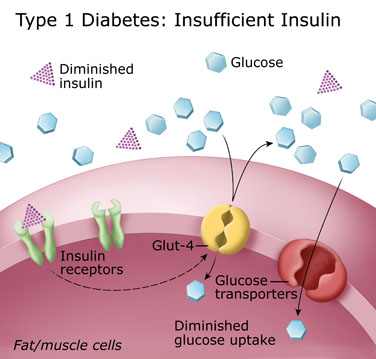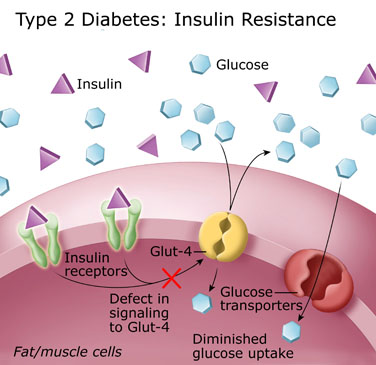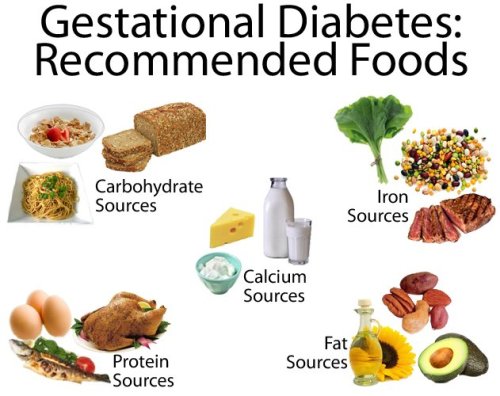Diabetes has emerged as a major healthcare problem in India. It is estimated that every fifth person with diabetes will be an Indian. Due to these sheer numbers, the economic burden due to diabetes in India is amongst the highest in the world. The real burden of the disease is however due to its associated complications which lead to increased morbidity and mortality. Much of the heart disease and stroke in these estimates was linked to diabetes.
Diabetes is a life-long disease marked by high levels of sugar in the blood. It can be caused by too little insulin (a hormone produced by the pancreas to regulate blood sugar), resistance to insulin (when cells in the body cannot effectively use insulin), or both. Diabetes can lead to serious health complications including heart disease, blindness, kidney failure, and lower-extremity amputations, such as a foot or lower leg.
Among adults with diagnosed type 1 or type 2 diabetes, 12% take insulin only, 14% take both insulin and oral medication, 58% take oral medication only, and 16% do not take either insulin or oral medication.
To understand diabetes, it is important to first understand the normal process of food metabolism. Several things happen when food is digested:
People with diabetes have high blood glucose because their pancreas does not make enough insulin or their muscle, fat, and liver cells do not respond to insulin normally (insulin resistance), or both.
There are three major types of diabetes:
Type 1 diabetes is usually diagnosed in childhood. The beta cell of the pancreas makes little or no insulin, and daily injections of insulin are required to sustain life. Without proper daily management, medical emergencies can arise. Type 1 diabetes was previously known as insulin-dependent diabetes mellitus (IDDM) or juvenile diabetes.

Type 2 diabetes is far more common than type 1 and makes up 90% or more of all cases of diabetes. Type 2 diabetes was formerly called adult-onset diabetes or noninsulin-dependent diabetes. It usually occurs in adulthood, although more cases are now occurring in children. Here, the pancreas does not make enough insulin to keep blood glucose levels normal, often because the body does not respond well to the insulin. Many people with type 2 diabetes do not know they have it, although it is a serious condition. Type 2 diabetes is becoming more common due to the growing number of older Americans, increasing obesity, and failure to exercise.

Gestational diabetesis high blood glucose that develops at the late stages of pregnancy in a person who does not have diabetes. Although gestational diabetes usually goes away after the baby is born, a woman may be at greater risk of developing type 2 diabetes later in life. Gestational diabetes can be caused by hormones or lack of insulin.

Indians develop diabetes at a very young age, at least 10 to 15 years earlier than the western population. An early occurrence of diabetes gives ample time for development of the chronic complications of diabetes. The incidence of diabetes increases with age. In India, the life span has increased, hence more number of people with diabetes are being detected.
The prevalence of diabetes increases with a family history of diabetes. The risk of a child developing diabetes with a parental history increases above 50 per cent. A high incidence of diabetes is seen among the first degree relatives. Indians have a high genetic risk for diabetes as observed in Asian Indians who have migrated to other countries. They have been found to have a higher rate of diabetes as compared to the local population.
The association of obesity with Type II Diabetes is well known. Even with an acceptable body weight range, weight gain could increase the risk of diabetes. An excess of body fat specially concentrated within the abdomen has an increased risk of diabetes. The cut-off limit for waist circumference for Indians have been recommended to be 90 cm for males and 80 cm for females. Abdominal obesity is defined by waist circumference above these limits.
There is enough evidence to demonstrate that physical inactivity as an independent factor for the development of type II diabetes. The availability of motorised transport and a shift in occupations combined with the plethora of television programmes has reduced the physical activity in all groups of populations.
Indians have been found to be more insulin resistant as compared to the white population. They have a higher level of insulin to achieve the same the blood glucose control. A cluster of factors consisting of abnormal fats (Dyslipidemia), high blood pressure, obesity, and abnormal glucose levels known as metabolic syndrome is highly prevalent in Asian Indians.
The developing countries like India are undergoing rapid urbanisation. Urbanisation is associated with increasing obesity, decreasing physical activity due to changes in lifestyle, diet and a change from manual work to less physical occupations.
The impact of stress both physical and mental along with lifestyle changes has a strong effect of increasing incidence of type II Diabetes amongst persons is a strong genetic background.
There is no cure for diabetes. The immediate goals are to stabilize your blood sugar and eliminate the symptoms of high blood sugar. The long-term goals of treatment are to prolong life, relieve symptoms, and prevent long-term complications such as heart disease, amputations, and kidney failure.
Lifestyle changes are the cornerstone of diabetes management for all patients. In addition to medication, achieving goals for weight management and diet, physical activity, smoking cessation, and moderate alcohol use is imperative for diabetes control.
Bariatic weight loss surgery may be an option for patients with a BMI over 35 kg/m2 and type 2 diabetes. After surgery, patients will need lifelong lifestyle support and medical monitoring.
Basic diabetes management skills will help prevent the need for emergency care. These skills include:
People with diabetes need to review and update their knowledge, because new research and improved ways to treat diabetes are constantly being developed.
Self-monitoring of blood glucose is done by checking the glucose content of a drop of blood. Regular testing tells you how well diet, medication, and exercise are working together to control your diabetes.
The results of the test can be used to adjust meals, activity, or medications to keep blood sugar levels in an appropriate range. Testing provides valuable information for the health care provider and identifies high and low blood sugar levels before serious problems develop.
The American Diabetes Association recommends that premeal blood sugar levels fall in the range of 80 to 120 mg/dL and bedtime blood levels fall in the range of 100 to 140 mg/dL. Your doctor may adjust this depending on your circumstances.
You should also ask your doctor how often you need to have your hemoglobin A1c (HbA1c) level checked. The HbA1c is a measure of average blood glucose during the previous two to three months. It is a very helpful way to monitor a patient's overall response to diabetes treatment over time. A person without diabetes has an HbA1c around 5%. People with diabetes should try to keep it below 7%. Usually HbA1c is checked every three months.
Ketone testing is another test that is used in type 1 diabetes. Ketones build up in the blood when there is not enough insulin in people with type 1 diabetes, eventually "spilling over" into the urine. The ketone test is done on a urine sample. High levels of blood ketones may result in a serious condition called ketoacidosis. Ketone testing is usually done at the following times:
Another complication that can be avoided by checking the blood sugar level is Hyperosmolar Hyperglycemic Nonketotic Syndrome (HHNS). HHNS is a serious condition usually seen in older persons with type 2 diabetes, although it can occur in type 1 patients also. HHNS is usually brought on by an illness or infection. HHNS only occurs when diabetes is uncontrolled. HHNS may occur gradually, and take days or even weeks to develop. The best way to avoid HHNS is to check your blood sugar regularly. Be aware of the symptoms of HHNS that include:
The onset of Diabetes may be delayed or altogether prevented in a great number of cases. Having a balanced diet is key to diabetes prevention. Exercising regularly and maintaining an ideal body weight is another major factor in prevention of diabetes. Obese people are at an elevated risk of developing diabetes. Avoidance of alcohol and tobacco also considerably reduce the risk of developing diabetes. Regular health checks to rule out diabetes are mandatory for everyone over the age of 40.
A National Urban Survey in 2000 observed that the prevalence of diabetes in urban India in adults was 12.1 per cent per cent. Recent data has illustrated the impact of socio-economic transition occurring in rural India. The transition has occurred in the last 15 years and the prevalence has risen from 2.4 per cent to 6.4 per cent. A National Urban Survey in 2000 observed that the prevalence of diabetes in urban India in adults was 12.1 per cent per cent. Recent data has illustrated the impact of socio-economic transition occurring in rural India. The transition has occurred in the last 15 years and the prevalence has risen from 2.4 per cent to 6.4 per cent.
Even after the diagnosis, monitoring of diabetes is very poor. Most of the patients initially visit a doctor and then discontinue their therapy once their symptoms and controlled. A majority of the patients abandon modern allopathic treatment in favour of indigenous treatments. Further, more patients with poor control avoid insulin for fear of injection and belief of addiction of insulin. Hence they keep changing doctors and hop from one system of treatment to another leading to further complications and early death. Lack of resources, medical reimbursement and poor state funding for diabetes is a barrier to quality care often because the patient is unable to afford the high cost of treatment.
There is ample evidence to suggest that preventive measures to reduce the burden of diabetes are needed. There is a need to spread the message that diabetes is preventable and we need to have a behavioural change to adopt a healthy lifestyle.